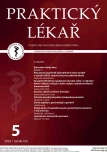24-hour movement behaviour of families with 3–8-year-old offspring and factors associated with reduced risk of childhood excess body weight
Authors:
E. Sigmund 1; J. Dygrýn 1; M. Vorlíček 1; J. Voráčová 2; D. Sigmundová 1
Authors‘ workplace:
Univerzita Palackého v Olomouci
; Fakulta tělesné kultury, Institut aktivního životního stylu, Vedoucí: Mgr. František Chmelík, Ph. D.
1; Fakulta tělesné kultury, Katedra společenských věd v kinantropologii, Vedoucí: doc. PhDr. Zbyněk Svozil, Ph. D.
2
Published in:
Prakt. Lék. 2023; 103(5): 232-239
Category:
Of different specialties
Overview
Objective: The main objective of the study is to use objective instruments to assess the 24-hour movement behaviour (i.e., sleep, sedentary behaviour and physical activity) of Czech families with 3–8-year-old children and to identify factors that reduce the risk of excess body weight in these children.
Methods: The set consists of a representative sample of 425 families from urban and rural municipalities in the regions of Bohemia, Moravia and Silesia. All family members completed 7 days of 24-hour monitoring of movement behaviour using wrist-worn accelerometers. The anthropometric data along with potential weight-related factors were collected via questionnaire and a family completed by parents. Body mass index z-scores and categorization by World Health Organization percentile charts differentiated by age and gender of the child were used to determine overweight and obesity. Binary logistic regression analysis was used to analyse factors reducing the risk of prevalence of childhood excess body weight.
Results: Children with excessive sitting were less likely to meet sleep and physical activity recommendations and were less likely to have breakfast with their parents than children with shorter daily sedentary time. There were no statistically significant differences between the prevalence of excess body weight in 3–8-year-old girls (19.2%) and boys (18.7%), contrary to parents, where fathers significantly (p < 0.05) outnumbered mothers in the prevalence of obesity (14.4%FATHER and 9.5%MOTHER) and overweight (46.5%FATHER and 20.1%MOTHER). The prevalence of obesity in parents significantly (p < 0.05) increased the risk of excess body weight in children, while shorter duration of sedentary behaviour significantly (p < 0.05) decreases the risk of excess body weight in children.
Conclusions: A child’s excessive sitting and parental obesity increases their risk of being overweight and obese, regardless of the socioeconomic status of the families or the gender of the children.
Sources
- WHO. Obesity and overweight [online]. Dostupné z: https://www. who.int/news-room/fact-sheets/detail/obesity-and-overweight [cit. 2023-10-5].
- Tapia-Serrano MA, Sevil-Serrano J, Sánchez-Miguel PA, et al. Prevalence of meeting 24-Hour Movement Guidelines from pre-school to adolescence: A systematic review and meta-analysis including 387,437 participants and 23 countries. J Sport Health Sci 2022; 11(4): 427–437.
- Rollo S, Antsygina O, Tremblay MS. The whole day matters: Understanding 24-hour movement guideline adherence and relationships with health indicators across the lifespan. J Sport Health Sci 2020; 9(6): 493–510.
- Sigmundová D, Badura P, Vokáčová J, et al. Parent-child behavioural patterns related to pre-schoolers’ overweight/obesity. Acta Gymnica 2017; 47(2): 53–63.
- Sigmundová D, Dygrýn J, Vorlíček M, et al. FAMIly Physical Activity, Sedentary behaviour and Sleep (FAMIPASS) study: protocol for a cross-sectional study. BMJ Open 2023; 13(8): e073244 [online]. Dostupné z: https://dx.doi.org/10.1136/bmjopen-2023-073244 [cit. 2023-10-4].
- Sigmund E, Sigmundová D. Pohybová aktivita, sedavé chování a obezita rodičů a jejich dětí [online]. Olomouc: Univerzita Palackého v Olomouci 2021. Dostupné z: https://dx.doi. org/10.5507/ftk.21.24458472 [cit. 2023-10-4].
- WHO. Guidelines on physical activity, sedentary behaviour and sleep for children under 5 years of age [online]. Geneva: World Health Organization 2019. Dostupné z: https://www.who.int/ publications-detail-redirect/9789241550536 [cit. 2023-10-4].
- Tremblay M, Carson V, Chaput J-P, et al. Canadian 24-hour movement guidelines for children and youth: an integration of physical activity, sedentary behaviour, and sleep. Appl Physiol Nutr Metab 2016; 41(Suppl 3): s311–s327.
- WHO. Guidelines on physical activity and sedentary behaviour [online]. Geneva: World Health Organization 2020. Dostupné z:
https://www.who.int/publications/i/item/9789240015128 [cit. 2023-10-4].
- Ross R, Chaput J-P, Giangregorio LM, et al. Canadian 24-hour movement guidelines for adults aged 18-64 years and adults aged 65 years or older: an integration of physical activity, sedentary behaviour, and sleep. Appl Physiol Nutr Metab 2020; 45(Suppl 2): s57–s102.
- WHO. Growth reference data for 5-19 years. WHO reference 2007 [online]. Dostupné z: https://www.who.int/tools/growth-refer- ence-data-for-5to19-years [cit. 2023-10-5].
- Woynarowska B, Palczewska I, Oblacińska A. Standardy WHO rozwoju fizycznego dzieci w wieku 0-5 lat. Siatki centylowe dlugosci/wysokosci masy ciala wskaznika masy BMI I obwodu glowy [WHO child growth standards for children 0-5 years. Percentile charts of length/height, weight, body mass index and head circumference]. Med Wieku Rozwoj 2012; 16(3): 232–239.
- WHO. WHO European Regional Obesity Report 2022. Copenhagen: WHO Regional Office for Europe 2022 [online]. Dostupné z: https://www.who.int/europe/publications/i/ item/9789289057738 [cit. 2023-10-10].
- Sigmund E, Baďura P, Voráčová J, a kol. Změny v prevalenci obezity českých adolescentů mezi lety 2018 a 2022 a její současné koreláty: HBSC studie. Prakt. Lék. 2023; 103(4): 195–201.
- Evensen E, Wilsgaard T, Furberg AS, et al. Tracking of overweight and obesity from early childhood to adolescence in a population-based cohort – the Tromsø Study, Fit Futures. BMC Pediatr 2016; 16: 64 [online]. Dostupné z: https://dx.doi.org/10.1186/
s12887-016-0599-5 [cit. 2023-10-10].
Labels
General practitioner for children and adolescents General practitioner for adultsArticle was published in
General Practitioner

2023 Issue 5
Most read in this issue
- Drug interactions with smoking and nicotine
- Health effects of coffee
- Ethical aspects in gerontology and geriatrics
- Liposarcoma of the spermatic cord
